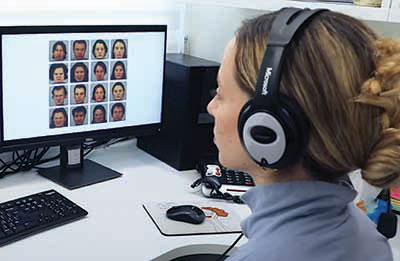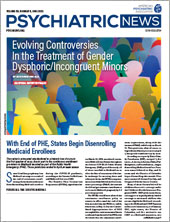An intervention that trains people to not focus on negative facial expressions is about as effective as the antidepressant escitalopram at reducing symptoms of social anxiety disorder, a
report in
AJP has found.
The intervention is known as gaze-contingent music reward therapy (GC-MRT). It involves showing participants a set of faces (that rotate every 20 seconds or so) on a computer screen outfitted with an eye-tracker; some faces in each set have neutral expressions and others have negative ones (for example, a scowl). Whenever participants fixate on a neutral face, they receive positive feedback in the form of music (from a music track they select); the music stops once they shift to a negative face.
Previous studies have shown that people with social anxiety disorder tend to dwell longer on faces that appear angry or scowling, thus contributing to their feelings of fear and avoidance.
“There has been a consistent effort to target attention in anxiety disorder therapy for over 20 years,” said study co-author Daniel Pine, M.D., chief of the Section on Development and Affective Neuroscience at the National Institute of Mental Health (Pine is also an associate editor for AJP).
The potential of GC-MRT to help people with social anxiety disorder was previously highlighted in a
study published in 2017. In that study, also co-authored by Pine, participants who received GC-MRT had significantly greater reductions in social anxiety symptoms than those who received a control intervention (also gazed at faces but music played throughout the session).
For the current study, Yair Bar-Haim, Ph.D., a professor of psychology and neuroscience at Tel Aviv University, together with Pine and colleagues, compared those receiving GC-MRT with those taking escitalopram. They randomized 105 adults with social anxiety disorder to receive either 10 sessions of GC-MRT over 12 weeks, up to 20 mg/daily escitalopram over 12 weeks, or be placed on a waitlist to receive GC-MRT sessions after 12 weeks. Participants in the GC-MRT group received an introductory session to explain the intervention in the first week. Beginning week 2 through week 5, the participants received 10, 20-minute GC-MRT sessions twice a week, as well as one session at weeks 8 and 11.
The researchers assessed the study participants halfway through the trial and again at week 13 using the clinician-rated total severity score on the Liebowitz Social Anxiety Scale. The participants also filled out the Social Phobia Inventory at these same time points.
Relative to the participants on the waitlist, those in the GC-MRT and escitalopram groups showed lower symptom severity at the midtreatment and posttreatment assessments. For comparison, the waitlist group showed minimal improvements on either scale. There was no statistical difference in the improvements achieved by patients in the GC-MRT or escitalopram groups.
“Escitalopram is a common first-line treatment for social anxiety,” said Bar-Haim. “I think these comparable outcomes reinforce that bias modification is a serious field, and that these tools will someday be part of psychiatry’s toolbox.”
Bar-Haim acknowledged that GC-MRT is not yet ready for the clinics, as multiple unknowns remain: For example, could GC-MRT be more effective when used in combination with medication or psychotherapy?
Pine, who is currently testing whether attention modification can augment cognitive-behavioral therapy for pediatric anxiety, agreed that more data are needed, particularly data from patients outside of controlled research settings.
“The work in attention modification has shown that anxiety in response trauma requires different training than anxiety in the absence of trauma,” he said. As a result, clinical trials for this attention-based intervention have often excluded patients with a history of posttraumatic disorder (PTSD).
“In community clinics, however, most people with anxiety don’t fall neatly into a specific [category]— that is, they either have PTSD or they are completely trauma free,” Pine continued.
Once more rigorous testing is completed, GC-MRT could be adapted quickly, Bar-Haim continued, since this program is not time-consuming and can be administered by a technician.
“Gaze-tracking devices are [also] becoming more affordable and more diverse,” he said. There are even virtual reality (VR) headsets that have built-in eye-tracking hardware; this suggests attention modification could be paired with VR simulations of social environments, which are another promising therapeutic area.
Bar-Haim added that he believes the attention bias training would be most effective if delivered in a clinical setting as opposed to at home. “We are targeting a very specific and delicate feedback mechanism, so you want the process to be in a conducive and distraction-free environment,” he said.
This study was funded by a grant from Joy Ventures and the NIMH Intramural Research Program. ■

